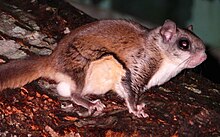Glaucomys volans
| Southern flying squirrel | |
|---|---|
 |
|
| Scientific classification | |
| Kingdom: | Animalia |
| Phylum: | Chordata |
| Class: | Mammalia |
| Order: | Rodentia |
| Family: | Sciuridae |
| Tribe: | Pteromyini |
| Genus: | Glaucomys |
| Species: | G. volans |
| Binomial name | |
|
Glaucomys volans (Linnaeus, 1758) |
|
 |
|
| Southern flying squirrel range | |
| Synonyms | |
|
[Mus] volans Linnaeus, 1758 |
|
[Mus] volans Linnaeus, 1758
Sciurus volans Pallas, 1778
S[ciuropterus] volans Jordan, 1890
Pteromys volans Swenk, 1915
The southern flying squirrel or the assapan (Glaucomys volans) is one of two species of the genus Glaucomys, the only flying squirrels found in North America (the other is the somewhat larger northern flying squirrel G. sabrinus). It is found in deciduous and mixed woods in the eastern half of North America, from southeastern Canada, to Florida. Disjunct distribution for populations of this species have been recorded in the highlands of Mexico, Guatemala, and Honduras.
Southern flying squirrels have grey brown fur on top with darker flanks and are a cream color underneath. They have large dark eyes and a flattened tail. They have a furry membrane called a patagium that extends between the front and rear legs and is used to glide through the air. Total length (including tail) is 21–26 cm (8.3–10.2 in). The tail can be 8–12 cm (3.1–4.7 in).
Southern flying squirrels are nocturnal, feed on fruit and nuts from trees such as red and white oak, hickory and beech. They store food, especially acorns, for winter consumption. They also dine on insects, buds, mushrooms, mycorrhizal fungi, carrion, bird eggs and nestlings and flowers. Predators include snakes,owls, hawks and raccoons. Domestic house cats can be dangerous to these animals.
...
Wikipedia

